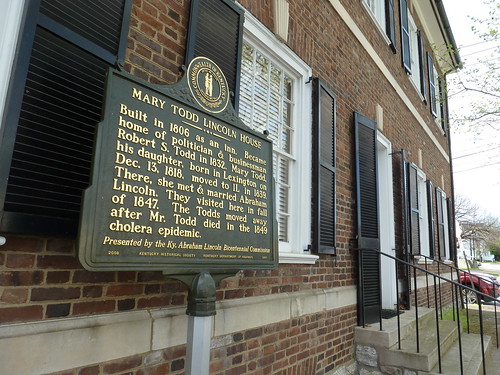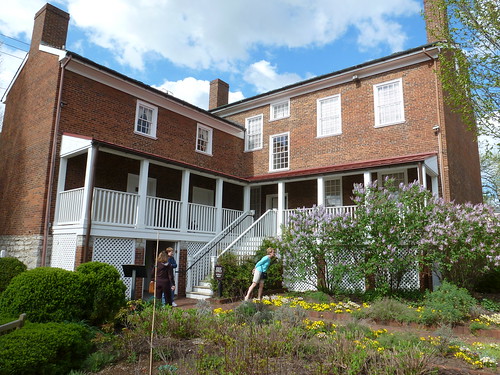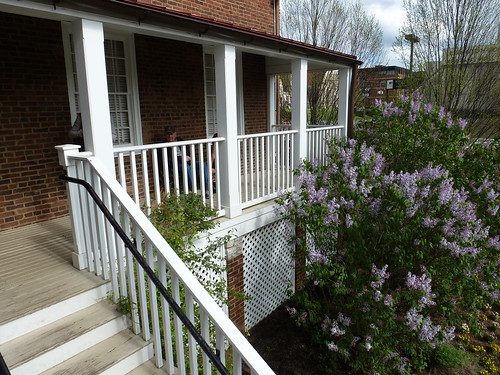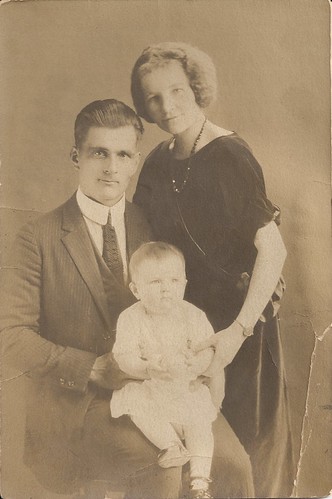The home museum of a famous authoress may not seem, on first consideration, a primary source for extant period garments and fashionable accessories. But when I visited the
Bronte Parsonnage Museum nine years ago, I was thrilled and very pleasantly surprised to find a display of gowns and some accessories owned and worn by Charlotte Bronte herself. The exhibit, which was set up in Charlotte's bedroom, included several gowns, a couple of bonnets, gloves, shoes, and some pieces of jewelry. The Bronte Parsonnage Museum has recently made most of their collection available in a
searchable online database, so I thought it would be only fitting to highlight some of my favorite pieces of clothing once worn by one of my all-time-favorite writers.
The Bronte Parsonnage, March 2003.
Charlotte Bronte's letters are full of discussions about fashion, yard goods, selecting bonnets, and making up gowns. She was a very petite woman; some acquaintances found her child-like and slightly old-fashioned. Her publisher, George Smith, wrote after her death that, "'I must confess that my first impression of Charlotte Brontë's personal appearance was that it was interesting rather than attractive. She was very small, and had a quaint old-fashioned look. Her head seemed too large for her body. She had fine eyes, but her face was marred by the shape of the mouth and by the complexion. There was but little feminine charm about her." Her sense of dress was modest; she once purchased a bonnet that seemed "grave and quiet" and demure enough in the shop, but worried once she got it home that its pink lining was "infinitely too gay" for her taste.
The gowns in the
Bronte Parsonnage Museum collection reflect the elegant simplicity of Charlotte's tastes. This one, a striped muslin printed with a small pattern, is very pretty and feminine, but has only the slightest amount of embellishment in the form of small frills on the bodice and the sleeves.
Printed muslin gown worn by Charlotte Bronte.
Bronte Parsonnage Museum item acquisition #D8.
When Charlotte was married on 29 June 1854 to Arthur Bell Nicholls, she wore a very simple, delicate white muslin gown and a green silk and lace bonnet. The bonnet has survived, but the gown was destroyed at the request of Nichols after his death in 1906 (Charlotte, of course, had died in 1855, only 9 months after their marriage). A replica was made reportedly by memory (by whose hands and from whose memory I have not been able to discover), however, and it is currently in the collection of the BPM, as is the wedding bonnet.
Replica of Charlotte Bronte's wedding gown.
Bronte Parsonnage Museum item acquisition #2003/17.
Elizabeth Gaskell wrote in
The Life of Charlotte Bronte that, "The news of the wedding had slipt abroad before the little party came out of church, and many old and humble friends were there, seeing her look 'like a snow-drop,' as they say. Her dress was white embroidered muslin, with a lace mantle, and white bonnet trimmed with green leaves, which perhaps might suggest the resemblance to the pale wintry flower."
Charlotte Bronte's wedding bonnet, 1854.
Bronte Parsonnage Museum item acquisition #D2.
For another, closer-up view of the bonnet, check out
this photo from flickr.
Charlotte's "going away" dress as in keeping with both her newly-married status and her preference for simple styles and subdued fabrics. It is made of a silver and mauve/lavendar striped shot silk, and features three pleats to fit the front bodice, which closes down center front with hooks and eyes. The collar and the sleeve cuffs are edged in velvet, and the musuem describes the waist detailing as "formed into small triangles, lined in cream silk fabric and trimmed with matching silk 10 pointed zig-zag fringing." It's very difficult to see this from the museum's picture (included below), and I honestly can't recall taking specific note of it myself when I saw it in person. Ah well, yet another excuse to have to go back again...:-)
Charlotte Bronte's "going away" dress, 1854.
Bronte Parsonnage Museum item acquisition #D74.1.
Has anyone ever attempted to do a reproduction of any of these gowns? Ever since I saw the last one at Haworth, I've been sorely tempted to try my hand at recreating it, but the proper fabric has proven elusive thus far. The search continues, so stay tuned!
**Update: Saturday, 31 March 2012**
Most exciting news!
Jenni has just informed me that the
Northern Society of Costume and Textiles, based in the UK, has produced a
scaled pattern of Charlotte's "going away" dress! The pattern can be ordered directly from their website at a very reasonable cost. You know where I'm headed right now...:-) Many thanks to Jenni for sharing this discovery!















